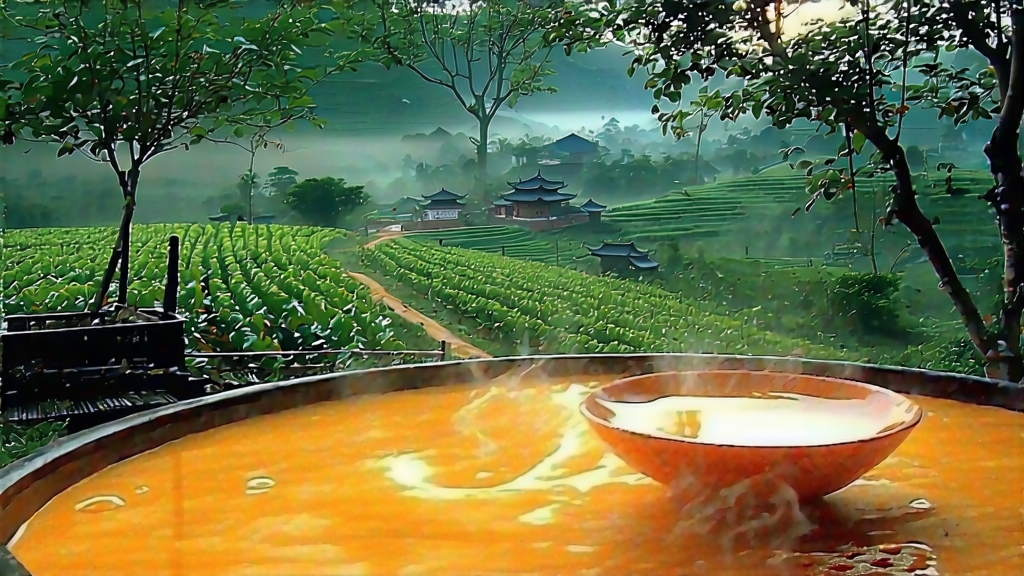
Liu Bao—pronounced “lyow-bow”—is the quiet diplomat of China’s dark-tea family. While Pu-erh grabs headlines, Liu Bao has spent four centuries smoothing its edges in mountain caves and riverboats, emerging with a mellow, malty sweetness that tastes like antique mahogany dipped in honey. Native to the small town of Liu Bao in Wuzhou, Guangxi Province, this tea was once ballast for rice traders sailing the Xun River to Hong Kong and Southeast Asia; the humid holds acted as mobile cellars, turning cargo into treasure. Today the same journey is simulated in climate-controlled warehouses, but the soul of the tea—its microflora, its mineral heartbeat—still belongs to the red-clay hills and subtropical mists of southern China.
History
The first written record appears in 1644, when a Ming scholar noted that “black baskets from Wuzhou calm the malarial stomach.” By the Qing dynasty Liu Bao was listed among the “24 famous teas” eligible for tribute, and in 1886 it won gold at the Panama-Pacific Exhibition in London, under the name “China Black Leaf.” Overseas Chinese in Kuala Lumpur and Singapore adopted it as a post-yum-cha digestif, believing its fungal enzymes cut through pork fat and herbal bitterness. During the 1970s rubber-boom, entire tongs (seven-basket bundles) were used as hard currency in Malaysian tin mines, their value rising with every river mile they traveled.
Leaf & Grade
Liu Bao is harvested from the large-leaf Camellia sinensis var. assamica that clings to the limestone karsts of Guangxi. Three grades are recognized by basket weight:
- First grade (gong xiang) 18–20 kg: tip-heavy, golden buds, cocoa finish.
- Second grade (yi ji) 23–25 kg: one bud-two leaves, orchid and bark.
- Third grade (san ji) 28–30 kg: mature leaves, earthy, betel-nut bite.
A fourth “special” grade, song zhen, is picked from 200-year-old wild trees on Gupo Mountain; only 300 baskets are released each year, each wrapped in banana leaf and signed by the tea master.
Craft: From Leaf to Basket
- Kill-green: 5 kg batches are pan-fired at 280 °C for eight minutes to arrest oxidation yet preserve leaf-eating fungi.
- Rolling: A 15-minute low-pressure roll bruises cells without breaking veins, preparing highways for later microbes.
- Sun-drying: Leaves are spread on bamboo mats for four hours, reaching 10 % moisture and absorbing guava-citrus notes from the mountain air.
- Wet piling (wo dui): Unique among dark teas, Liu Bao uses local spring water infused with mineral-rich red-clay. Piles 70 cm high are covered with jute sacks and misted every 12 hours; internal temperature climbs to 55 °C, activating Eurotium cristatum—the same golden “flower” that appears on Fu brick. After 25–30 days the leaf turns chestnut brown and develops a mushroom-bouillon umami.
- Steam & press: The fermented leaf is re-steamed for 30 seconds, then hand-tamped into cylindrical bamboo baskets lined with wild taro leaves. Pressure is applied by a 50 kg stone dial, giving the finished basket its dimpled top.
- Cave aging: Baskets are stacked in natural limestone caves at 25 °C and 85 % humidity for a minimum of three years; during this time the taro leaf imparts a faint vanilla note while the tea slowly oxidizes, losing astringency and gaining ruby clarity.
The Art of the Brew
Western parameters: 5 g leaf, 350 ml soft water, 95 °C, 3 min first infusion, +30 s for each next.
Gongfu ceremony: 120 ml Yixing zi-sha teapot seasoned only with Liu Bao; 8 g leaf; 100 °C rinse discarded; steep 1-2-3-5-7-10-15-30-60 s, yielding nine transparent infusions that arc from cacao to dried longan to camphor.
Malaysian kopitiam style: boil 15 g in 1 L water for three minutes, add evaporated milk and a pinch of salt—called “cham”